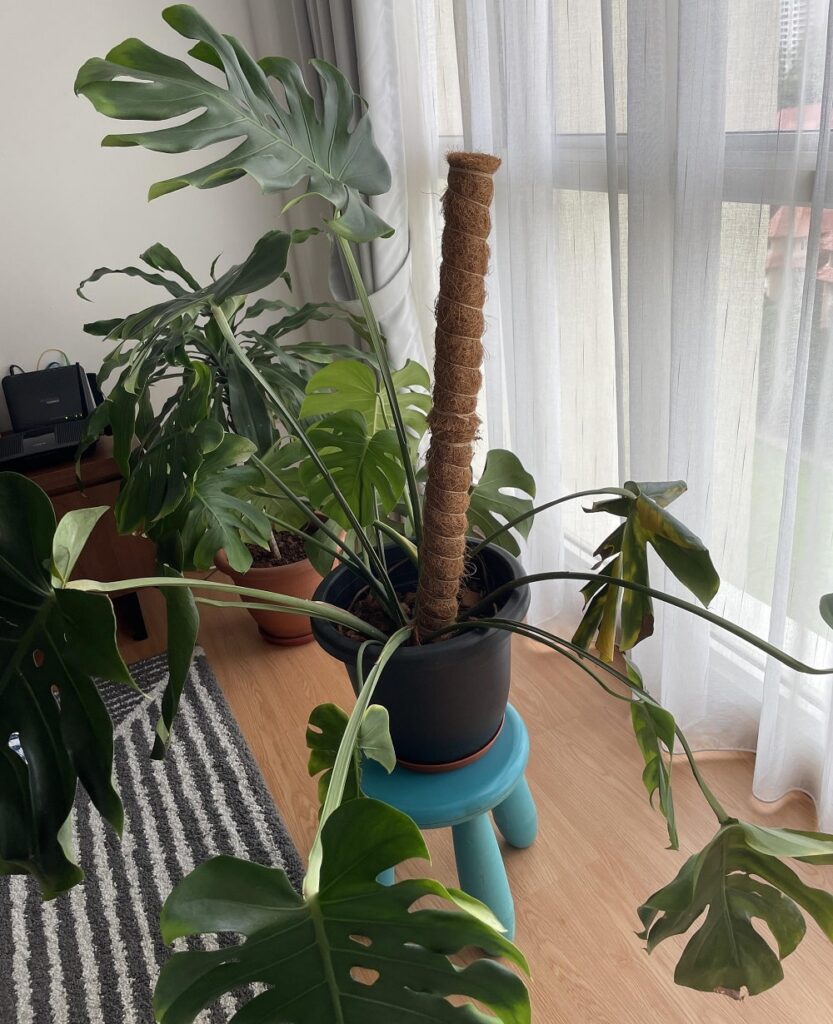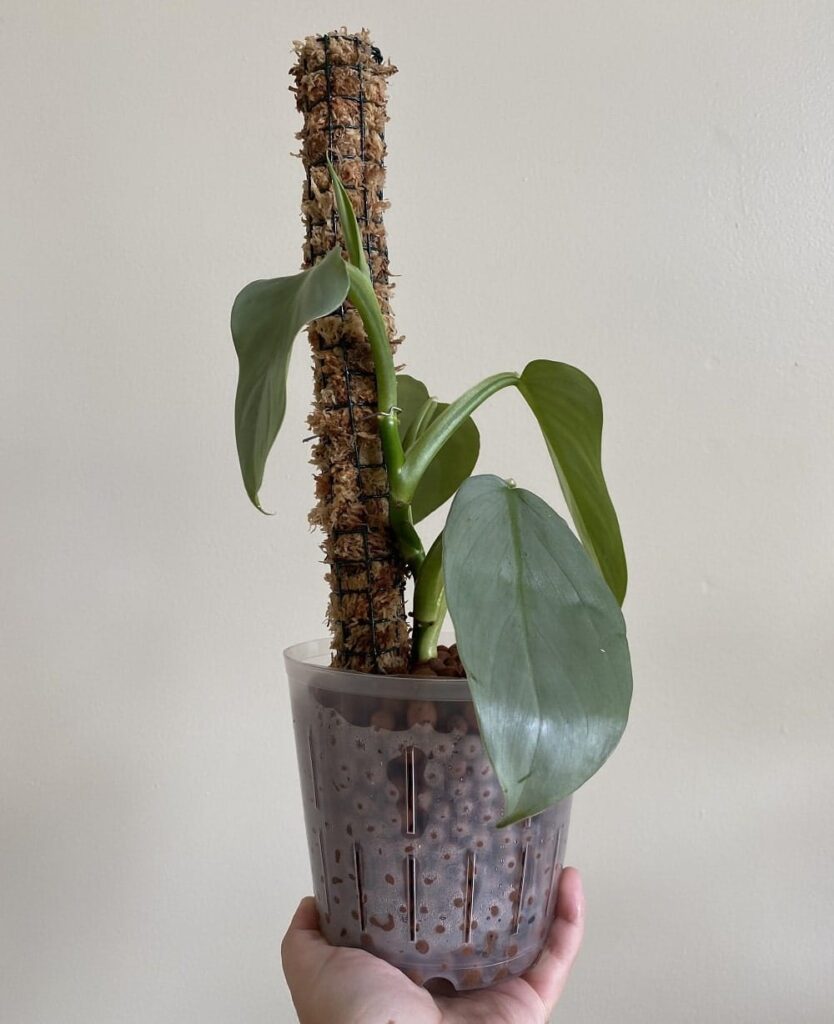When I started growing tropical climbing houseplants, I used to find it challenging to train them to grow upward and maintain standard humidity requirements. After thorough research, the moss pole was the perfect solution.
The moss pole provides extra support and helps the indoor plant to grow up. Besides that, it enables the aerial roots to absorb atmospheric moisture. But the most challenging thing with the moss pole is to learn how to keep it moist.
So, how do you keep moss pole moist? You can either spray water directly or use a wicking system to keep the moss pole moist. Increase the indoor humidity level to allow the moss pole to hold moisture for an extended period.
Keep reading this article to learn how to keep moss pole moist and their importance to tropical climbing plants. You’ll also learn how to use a moss pole for climbing plants and moss pole alternatives.
You May Also Read: How Do Self-Watering Pots Work?

How to Keep Moss Pole Moist (Tested Strategies)
Moss poles are incredible products for climbing houseplants. It offers a surface for the aerial roots to cling and enable the plant to grow upward.
The indoor environment usually experiences humidity fluctuation. Keeping the moss pole moist will help to relieve the hustle of misting the houseplant more often.
Learning how to keep a moss pole moist happens to be a crucial thing to consider. I recommend using a drip water bottle or a wicking system.
Method 1: Use a Drip Water Bottle
You can use a drip water bottle to keep your moss pole moist. A plastic bottle and tape are vital materials for making this simple device.
Use a two-liter or even bigger bottle based on the size of the moss pole. Make two holes on the bottle cap using a hot needle.
Fill the bottle with water and put the cap on it. Tape the bottle to the top of the moss pole and put it in a safe place free from disturbances. Reinforce it with a wire to hold the bottle.
The water will drip slowly to keep the moss pole moist throughout. The method is ideal for those houseplants that love more humidity levels.
Method 2: Use a Wicking System
It is the most recommended method for keeping moss poles moist. The strategy fosters better plant growth and health in the planters.
The wicking system works by absorbing water from the pot and feeding it up to the moss pole. The capillary action ensures the moss pole is moist throughout the growing period.
The technique enables the houseplant to develop healthy aerial roots and several leaves. To get a better result, you need to choose quality wicking cords.
Tie these wicking cords at the moss pole end and dip them in the planter with water. These cords will wick up and keep the pole moisturized.
How to Keep Moss Pole Moist for Longer Periods
External environmental conditions play a vital role when it comes to regulating moss pole moisture content. These factors also affect plant growth and health in the long run.
There are several strategies to keep moss poles moist for an extended period. You’ll need to keep these external environment conditions under control.
Use a Humidifier
Indoor condition is more vulnerable to humidity fluctuation. Dry air makes the moist moss pole lose more water to the surrounding. It becomes challenging for the moss pole to retain more moisture.
Installing a humidifier will help to increase humidity in the house. High humidity will enable the moss pole to hold moisture for an extended period. Be sure to keep the humidifier away from wooden furniture.
Keep the Moss Pole Away from Windy Areas
Wind help plants to grow faster. But too much wind has the chance of harming longer plants than short plants. It also makes the moisture evaporate out of the moss pole at a higher rate.
Keeping the growing houseplant away from windy areas will help the moss pole stay moisturized. Remember to keep leggy and fragile plants in less windy areas.
Keep the Moss Pole in Cool Areas
Sunlight makes the plants to be self-sufficient. But too much heat from direct sunlight can evaporate water from any plant surfaces like leaves or moist moss poles.
The best option is to keep the moist moss pole in a cool area. Ensure the region receives medium to bright indirect sunlight to enhance photosynthesis and reduce the evaporation rate.
Related Questions
Do You Have to Soak a Moss Pole?
Yes. Soaking the moss pole is another way of keeping it moist. The aerial roots will absorb the water and latch fully on the pole.
Does My Monstera Need a Moist Pole?
Monstera is a vining plant in its natural habitat. It makes use of aerial roots to climb tree branches in its native habitat. A moss pole will help to provide the necessary support when growing the plant in the house.
What Are Moss Poles Made Out Of?
It consists of thick wooden dowel, sphagnum moss, and strings. The thick wooden dowel offers a surface for tying the sphagnum moss.
Do You Need to Keep Moss Pole Wet?
Yes. It provides another source of water for the vines. It also allows easy aerial root attachment to enhance a more attractive growth habit.
What Are Moss Pole Alternatives?
A natural bamboo trellis and tree slab. These moss pole alternatives usually mimic the natural habitat for trailing vines. They enable the plant to experience better growth and health.
Where Can I Find Sphagnum Moss?
Sphagnum mosses occur in moist tundra areas, conifer forests, and peat bogs. But you can also buy them from online plant stores.
You May Also Enjoy: How to Make Homemade Fertilizers for Indoor Plants

In Conclusion
Climbing houseplants need ultimate attention to thrive to the fullest. You’ll need to come up with a plan that facilitates upward growth. Moss poles are excellent products that help to provide the necessary support.
Moss poles allow these climbing plants to develop stunning, large, and lushful leaves. It also helps to organize the plant in the space apart from enhancing upward growth. Keeping the moss pole moist tends to be more helpful to the plant.
Learning how to keep moss pole moist for an extended period is crucial. I hope the information provided above will guide you to soak a moss pole according to the set standards. Keep in mind that some climbing plants hate high humidity.
